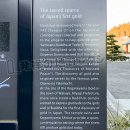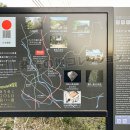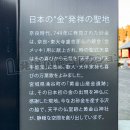金 発祥の聖地
きんはっしょうのせいち
石巻線 涌谷駅から北へ3km、わくや万葉の里 天平ろまん館(遠田郡涌谷町涌谷黄金山1-3)の駐車場の身体障害者枠近くに、黒いシックな装いの日本遺産を説明する看板が掲出されている。
写真
碑文
日本の“金”発祥の聖地
奈良時代、749年に発見された砂金は、奈良・東大寺の盧舎那仏の鍍金(金メッキ)用に献上され、時の聖武天皇はその喜びから元号を「天平」から「天平感宝」に改め、歌人・大伴家持も喜びの万葉歌をよみました。
宮城県涌谷町の「黄金山産金遺跡」は、その日本初の金の出現を神仏に感謝した現地。今なお砂金を参する沢の脇で、天平の仏堂跡と黄金山神社が、静穏な空間を創り出しています。The sacred source of Japan's first gold
Gold dust discovered here in the year 749 (Tenpyo 21 on the Japanese calendar) was collected and presented to the emperor to help gild the great Vairocana-Buddha at Todai-ji Temple in Nara. Delighted with the offering, Emperor Shomu decreed that the official era name be changed from Tenpyo ("Blesse Peace") to Tenpyo-kanpo ("Wondrous Treasures of Blessed Peace"). The discovery of gold also inspired verses by the famous poet, Otomo no Yakamochi.
At the site of the Koganeyama Gold in the town of Wakuya, Miyagi Prefecture, there once stood a Buddhist temple erected to express gratitude to the gods and to Buddha for the first discovery of gold in Japan. The temple ruins and Koganeyama Shrine provide a quiet, contemplative setting where the rivers still produce gold dust today.




コメント